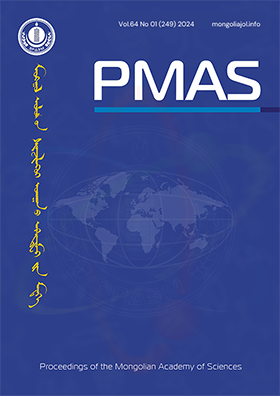Dispersion mapping of Carbon Monoxide (CO) derived Sentinel 5P and evaluation with LUR model during winter in Ulaanbaatar, Mongolia
DOI:
https://doi.org/10.5564/pmas.v64i01.3545Keywords:
Carbon Monoxide, Sentinel 5P TROPOMI, LUR model, Ulaanbaatar cityAbstract
In recent years, air pollution caused by coal combustion in Ulaanbaatar city is becoming a priority health concern for the city residents and many researchers are investigating its ingredient and impact on people's health. This study aims to map Carbon Monoxide (CO) dispersion from remote sensing data during the winter season and evaluate it with the Land Use Regression (LUR) model result and fixed station measurements. Fixed station data from the National Agency for Meteorological and Environmental Monitoring (NAMEM) were utilized as a reference point for remote sensing data, a dependent variable for LUR model. Sentinel 5P TROPOMI CO data was correlated moderately-positive with fixed station measurements (R=0.56). And LUR model performance was relatively higher compared to Sentinel data or its determination coefficient R2=0.71, Adjusted R2=0.53, Root Mean Square Error (RMSE)=0.84 mg/m3 and Mean Absolute Error (MAE)=0.7 mg/m3. These statistical evaluation coefficients are relatively lower than other similar studies, and authors have adduced it to a lack of reference data and satellite data spatial resolution. Finally, these two result maps were compared, which have shown lower correlation-positive or R=0.44. Even though these two map results are not exactly the same, Pearson’s correlation coefficient shows that both image results move in the same direction or they are moderately showing the same results.
Downloads
517
References
I. Ialongo, H. Virta, H. Eskes, J. Hovila, and J. Douros, “Comparison of TROPOMI/Sentinel-5 Precursor No 2 observations with ground-based measurements in Helsinki,” Atmospheric measurement techniques, Vol. 13, No. 1, pp. 205-2018, 2020. https://doi.org/10.5194/amt-13-205-2020
V. Safarianzengir, B. Sobhani, M. H. Yazdani, and M. Kianian “Monitoring, analysis and spatial and temporal zoning of air pollution (carbon monoxide) using Sentinel-5 satellite data for health management in Iran, located in the Middle East,” Springer: Air quality, Atmosphere and health, Vol. 13, pp. 709-719, 2020. https://doi.org/10.1007/s11869-020-00827-5.
A. Arfani, M. Dadang Basuki, and A. Wibowo, “Carbon Monoxide spatial pattern based on vehicle volume distribution in Tangerang city,” International Journal of Remote sensing and Earth sciences, Vol. 19, No. 1, 2022. https://doi.org/10.30536/j.ijreses.2022.v19.a3789.
World Health Organization, “WHO. Ambient (Outdoor) Air Pollution,” 12 December 2022. [Online]. Available: https://www.who.int/news-room/fact-sheets/detail/ambient-(outdoor)-air-quality-and-health.
Mongolian Agency for Standard Metrology, “Air quality. General technical requirements,” Ulaanbaatar, 2007. [Online]. Available: https://old.estandard.gov.mn/standard/v/3377
D. Warburton et al., “Impact of Seasonal Winter Air Pollution on Health across the Lifespan in Mongolia and Some Putative Solutions,” Annals of the American Thoracic Society, 2018. https://doi.org/10.1513/AnnalsATS.201710-758MG.
B. Jargalmaa, “Icon news,” 3 February 2019. [online]. Available: https://ikon.mn/n/1hus. [Accessed 5 May 2023].
National Agency for Meteorology and Environmental Monitroing, “Air pollution sources 2022,” Ulaanbaatar, [Online]. Available: http://www.agaar.mn/files/article/664/Agaariin%20bohirdliin%20tuhai%20tovchhon.pdf
O.Ekhjargal, B.Bumtsend and R.Tovuudorj, “Landform classification based on topographic position Index,” Mongolian Journal of Geography and Geoecology, Vol. 59, pp. 218–226, 2022. https://doi.org/10.5564/mjgg.v59i43.2530.
P. K. Davy, “Air particulate matter pollution in Ulaanbaatar, Mongolia: Determination of composition, source contributions and source locations,” Science direct: Atmospheric Pollution Research, Vol. 2, No. 2, pp. 126-137, 2011. https://doi.org/10.5094/APR.2011.017.
D. Amarsaikhan, V. Battsengel, B. Nergui et al, “A Study on Air Pollution in Ulaanbaatar City,” Journal of Geoscience and Environment Protection, Vol. 2, pp. 123-128, 2014. https://doi.org/10.4236/gep.2014.22017.
S.K. Guttikunda, S.Lodoysamba, B.Bulgansaikhan, “Particulate pollution in Ulaanbaatar, Mongolia,” Air Quality, Atmosphere & Health, Vol. 6, pp. 589-601, 2013. https://doi.org/10.1007/s11869-013-0198-7.
G.Ganbat, H. Lee, H-W Jo, B.Jadamba and D.Karthe “Assessment of COVID-19 Impacts on Air Quality in Ulaanbaatar, Mongolia, Based on Terrestrial and Sentinel-5P TROPOMI Data,” Aerosol and Air Quality Research, Vol. 22, No. 10, 2022. https://doi.org/10.4209/aaqr.22019.6
World Bank, “Air Quality Analysis of Ulaanbaatar Improving air quality to reduce health impacts,” World Bank, Washington, 2011. [Online]. Available: https://documents.worldbank.org/pt/publication/documents-reports/documentdetail/126141468288034414/main-report
O.Enkhjargal, M.Lamchin, J.Chambers and X-Y You, “Linear and Nonlinear Land Use Regression Approach for Modelling PM2.5 Concentration in Ulaanbaatar, Mongolia during Peak Hours,” MDPI: Remote sensing, Vol. 15, pp. 1174, 2023. https://doi.org/10.3390/rs15051174.
European Space Agency, “Sentinel Online,” European Union, [Online]. Available: https://sentinels.copernicus.eu/web/sentinel/data-products/-/asset_publisher/fp37fc19FN8F/content/sentinel-5-precursor-level-2-carbon-monoxide.
A.Vellalassery et al, “Using Tropospheric Monitoring Instrument (TROPOMI) measurements and Weather Research and Forecasting (WRF) CO modelling to understand the contribution of meteorology and emissions to an extreme air pollution event in India,” Atmospheric Chemistry and Physics, Vol. 21, 2021. https://doi.org/10.5194/acp-21-5393-2021.
G.Kaplan and Z. Yi̇Gi̇T Avdan “Space-borne air pollution observation from Sentinel-5p Tropomi: relationship between pollutants, geographical and demographic data,” International Journal of Engineering and Geosciences, Vol. 5, 2020. https://doi.org/10.26833/ijeg.644089.
National Agency for Meteorology and Environmental Monitoring, “Fixed stations data,” Ulaanbaatar city, 2023.
H.J. Jumaah, M. H. Ameen and B.Kalantar et al., “Air quality index prediction using IDW geostatistical technique and OLS-based GIS technique in Kuala Lumpur, Malaysia,” Geomatics, Natural Hazards and Risk, Vol. 10, 2019. https://doi.org/10.1080/19475705.2019.1683084.
C. Хu, J. Wang, M. Hu, and W. Wang “A new method for interpolation of missing air quality data at monitor stations,” Еlsevier: Environment International, Vol. 169, 2022. https://doi.org/10.1016/j.envint.2022.107538.
Europian Union, “Sentinel Hub,” [online]. Available: https://apps.sentinel-hub.com/eo-browser/?zoom=6&lat=33.5&lng=41.24&themeId=Default-Theme. [Accessed 30 May 2023].
T. Borsdorff, J. Aan de Brugh , H.Hu, I.Aben, O. Hasekamp, and J. Landgraf, “Measuring Carbon Monoxide With Tropomi: First Results and a Comparison With ECMWF-IFS Analysis Data,” Geophysical Letters, Vol. 45, pp. 2826-2832, 2018. https://doi.org/10.1002/2018GL077045.
G. Kaplan, Z.Y. Avdan, “Space-borne air pollution observation from Sentinel-5p TROPOMI: relationship between pollutants, geographical and demographic data,” International Journal of Engineering and Geosciences, Vol. 5, pp. 130-137, 2020. https://doi.org/10.26833/ijeg.644089.
Downloads
Published
How to Cite
Issue
Section
License
Copyright (c) 2024 Odbaatar Enkhjargal, Davaagatan Tuyagerel, Renchinmyadag Tovuudorj, Zolzaya Khurelsukh, Enkhmaa Sarangerel

This work is licensed under a Creative Commons Attribution 4.0 International License.
Copyright on any research article in the Proceedings of the Mongolian Academy of Sciences is retained by the author(s).
The authors grant the Proceedings of the Mongolian Academy of Sciences a license to publish the article and identify itself as the original publisher.

Articles in the Proceedings of the Mongolian Academy of Sciences are Open Access articles published under a Creative Commons Attribution 4.0 International License CC BY.
This license permits use, distribution and reproduction in any medium, provided the original work is properly cited.

